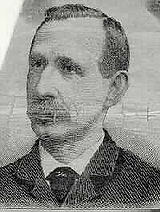
Young Barney Aaron
Encyclopedia

Boxing
Boxing, also called pugilism, is a combat sport in which two people fight each other using their fists. Boxing is supervised by a referee over a series of between one to three minute intervals called rounds...
.
The son of Hall of Famer Barney Aaron
Barney Aaron
Barney Aaron was an English bare-knuckle boxer.The father of Hall of Famer Young Barney Aaron began boxing in 1819 and became a Lightweight Champion in the 1820s. Called The Star of the East, Aaron got victories over William Connelly, Ned Stockton, Lenney, Frank Redmond and Peter Warren...
, he emigrated to the United States in 1855, and began boxing in 1856. Aaron became a U.S. Lightweight
Lightweight
Light-weight is a class of athletes in a particular sport, based on their weight.-Professional boxing:The lightweight division is over 130 pounds and up to 135 pounds weight class in the sport of boxing....
Champion.
Boxing career
Like his father before him, Aaron was a hard-hitting bare-knuckled fighter, but he fought in a new era under different rules than his famous father. The elder Aaron battled under "Broughton's Rules"; Young Barney fought under the Pugilistic Society's "London Prize Ring RulesLondon Prize Ring rules
The London Prize Ring Rules was a list of boxing rules promulgated in 1838 and revised in 1853. These rules were based on those drafted by Britain's Jack Broughton in 1743 and governed the conduct of prizefighting/bare-knuckle boxing for over 100 years...
," which had been developed in 1838. Modified in 1853, only three years before young Barney began his professional career, the Rules stated the ring should be 24 square feet (2.2 m²), surrounded by two ropes. Any knockdown marked the end of the round, and the downed fighter had 8 seconds to "come to scratch" unaided, or the fight was over -- under Broughton's Rules, a fighter had 30 seconds to return to the center of the ring, and had the help of his handlers. Therefore, bouts were recorded according to the number of rounds and length of time; 3-minute rounds were not developed until the late-19th century.
On July 9, 1856, on Rikers Island
Rikers Island
Rikers Island is New York City's main jail complex, as well as the name of the island on which it sits, in the East River between Queens and the mainland Bronx, adjacent to the runways of LaGuardia Airport. The island itself is part of the borough of the Bronx, though it is included as part of...
, Aaron fought a mulatto named Robinson beginning at daybreak. The bout lasted for 80 rounds, 2 hours and 20 minutes, and resulted in Aaron being declared the winner.
On September 2, 1857, he defeated American Lightweight Champion Johnny Moneghan
Johnny Moneghan
Johnny Moneghan was a lightweight bare-knuckle boxer.He gained the recognition of becoming the first official Lightweight Champion of America...
in Providence, RI over 80 rounds. The fight lasted 3 hours and 20 minutes. With the victory he became the first Jewish fighter to win a ring championship in America.
After losing the title the following year to Patrick “Scotty” Brannagan in 1858 on a foul, he entered a seven-year period of inactivity because no fighter would face him.
He returned to the ring in 1866, and lost a 47-round bid to regain the title against Sam Collyer
Sam Collyer
Sam Collyer was a lightweight bare-knuckle boxer. He was of Scottish-French descent, weighed between 115 and 125 pounds, and stood 5 feet 5 ½ inches.-Early life:...
. After an excruciating 2 hours and 5 minutes, both men were taken off on stretchers. However, he defeated Collyer in the rematch on June 13, 1867, in a 68-round battle that lasted one hour and 55 minutes to regain the championship.
He won newspaper headlines in July 1874 for foiling two pickpockets trying to steal from the Rev. Henry Thorpe, whom they jostled as the elderly clergyman was "riding downtown on a Fourth Avenue [street] car." Aaron applied some of his celebrated "scientific boxing" technique, knocking both thieves down into the street, after first having retrieved the reverend's gold watch, which he returned.
His most famous bout was a 17-round win over Arthur Chambers
Arthur Chambers
Arthur Chambers was an Anglo-American boxer.-Career:...
in 1878.
In retirement, Young Barney remained in boxing by operating a gym in New York. He also served as a referee and officiated the 1883 John L. Sullivan
John L. Sullivan
John Lawrence Sullivan , also known as the Boston Strong Boy, was recognized as the first heavyweight champion of gloved boxing from February 7, 1881 to 1892, and is generally recognized as the last heavyweight champion of bare-knuckle boxing under the London Prize Ring rules...
vs. Herbert Slade bout.

